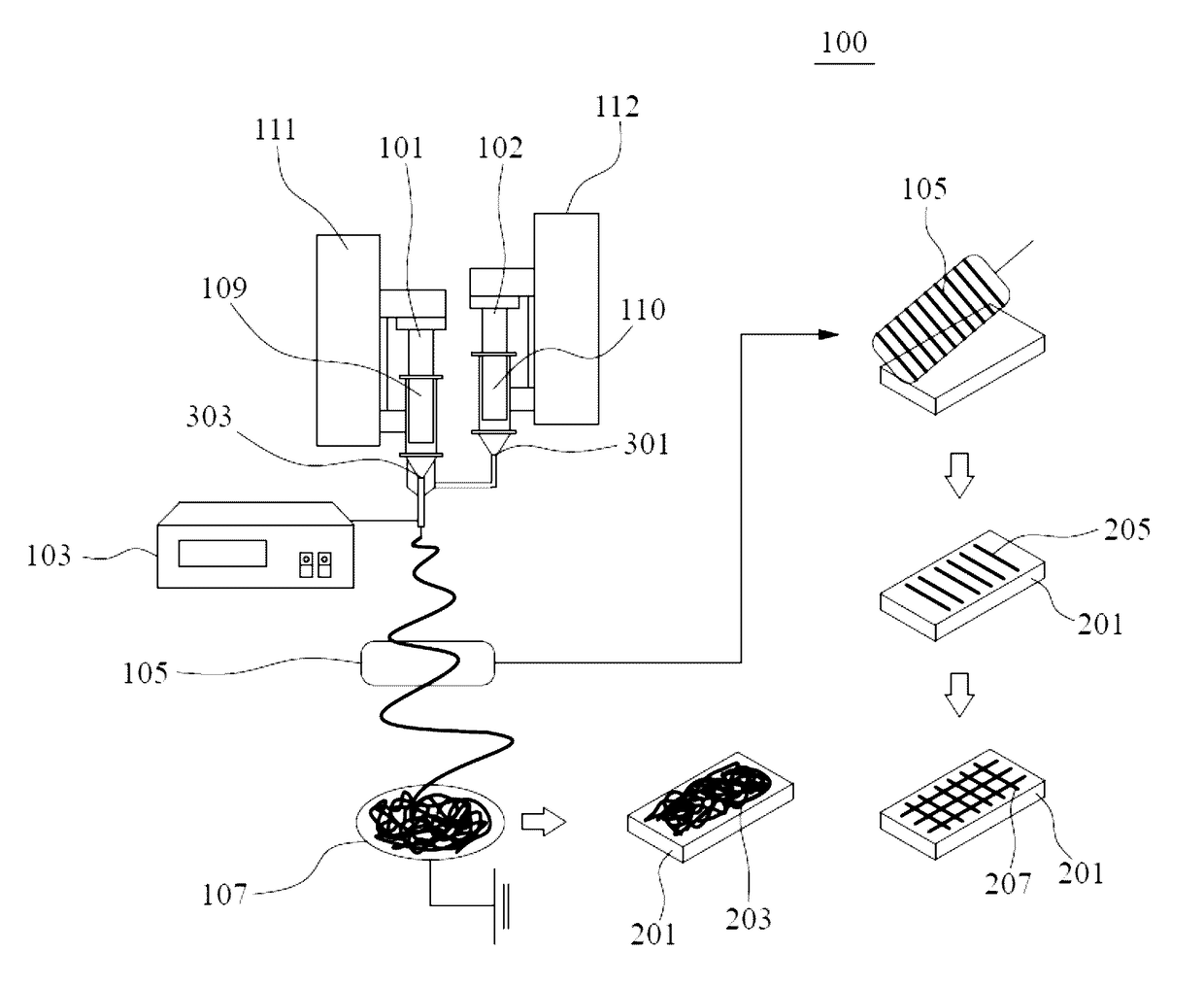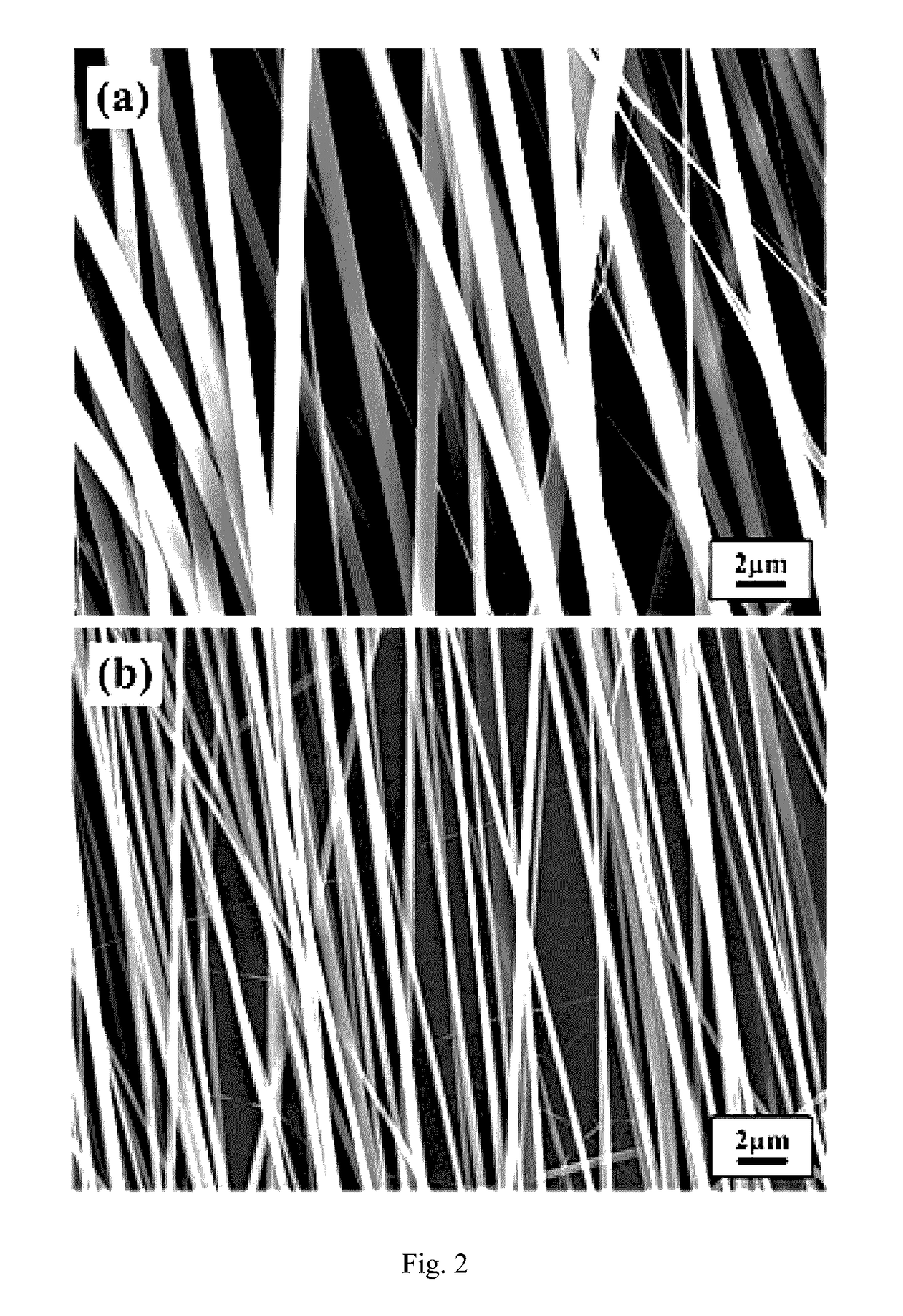Nanofiber and photovoltaic device comprising patterned nanofiber
a nanofiber and photovoltaic technology, applied in the field of nanofibers, can solve the problems of not exploring the effect of the fiber architecture on the opv performance, the quantum efficiency of opv is relatively limited, and the application of such nanofibers in bulk-heterojunction opv devices has not been explored, so as to improve the charge drift velocity, reduce the electrical resistance, and enhance the exciton generation of p3ht
- Summary
- Abstract
- Description
- Claims
- Application Information
AI Technical Summary
Benefits of technology
Problems solved by technology
Method used
Image
Examples
example 1
Preparation of the Ag / PVP Composite Nanofibers (AgF-1)
[0039]FIG. 1 illustrates the coaxial Electrospinning (ES) devices and its use of manufacturing for non-woven, aligned, or crossed-pattern nanofiber layer. As FIG. 1 showed, the nanofiber and the photovoltaic devices containing the same can be prepared using the preparation procedures described in the following. Using two-fluid coaxial electrospinning technique, grounded modified collector 107 was employed to produce aligned core / shell nanofibers. Specifically, two syringes 101, 102 containing core and shell solutions 303, 301 respectively were connected to separate needles 109, 110, and the needle 109 was placed one inside the other to form a two-fluid coaxial ES system 100. The core and shell solutions 303, 301 were fed into the coaxial capillaries by two syringe pumps 111, 112 (KD Scientific Model 100, USA).
[0040]30 mg Silver oxide (Ag2O, ≧99.99% trace metals basis) were added into ammonium hydroxide solution (ACS reagent, 28.0...
example 2
Preparation of the Ag / PVP Composite Nanofibers (AgF-2)
[0045]The example was prepared using the same preparation procedures as Example 1, except that 30 mg Ag2O was replaced by 5 mg Ag2O to add into 1 ml ammonium hydroxide solution to form Ag(NH3)2+ complex ion as the core solution 303 of AgF-2. 100 mg mL−1 of PVP dissolved in methanol as shell solution 301 of AgF-2 with 30 wt % of TBAP was added to increase conductivity and then stabilize the cone-jet. The same method as Example 1 was used to characterize the morphology and electrical property of the nanofibers.
example 3
Preparation of the Ag / PVP Composite Nanofibers (AgF-3)
[0046]The example was prepared using the same preparation procedures as Example 1, except that 30 mg Ag2O was replaced by 1 mg Ag2O to add into 1 ml ammonium hydroxide solution to form Ag(NH3)2+ complex ion as the core solution 303 of AgF-3. 100 mg mL−1 of PVP dissolved in methanol as shell solution 301 in AgF-3 with 30 wt % of TBAP added to increase conductivity and then stabilize the cone-jet. The same method as Example 1 was used to characterize the morphology and electrical property of the nanofibers.
PUM
| Property | Measurement | Unit |
|---|---|---|
| diameter | aaaaa | aaaaa |
| diameter | aaaaa | aaaaa |
| size | aaaaa | aaaaa |
Abstract
Description
Claims
Application Information
 Login to View More
Login to View More - R&D
- Intellectual Property
- Life Sciences
- Materials
- Tech Scout
- Unparalleled Data Quality
- Higher Quality Content
- 60% Fewer Hallucinations
Browse by: Latest US Patents, China's latest patents, Technical Efficacy Thesaurus, Application Domain, Technology Topic, Popular Technical Reports.
© 2025 PatSnap. All rights reserved.Legal|Privacy policy|Modern Slavery Act Transparency Statement|Sitemap|About US| Contact US: help@patsnap.com



